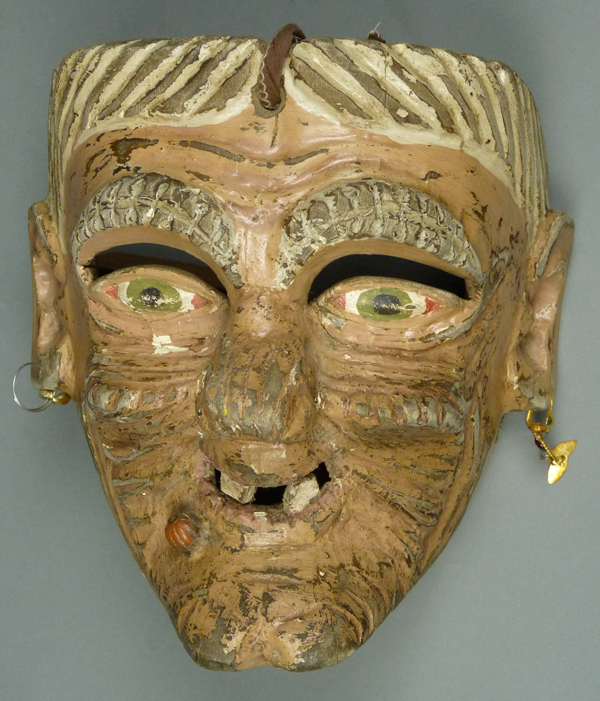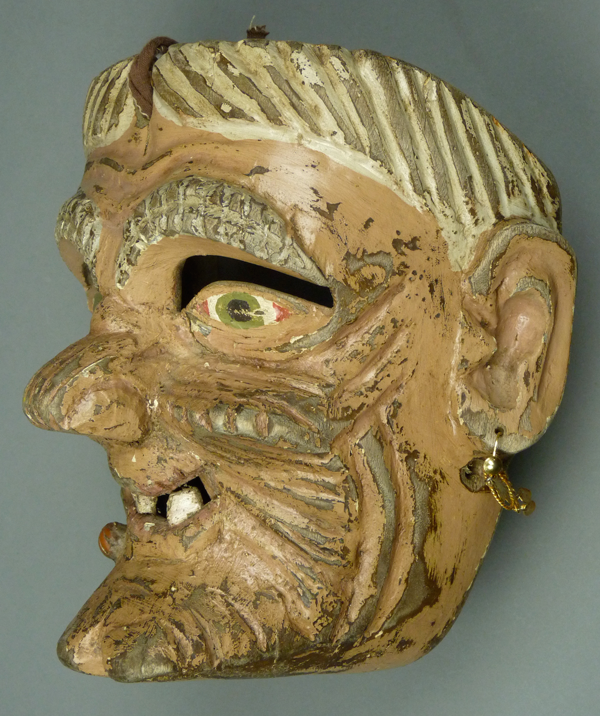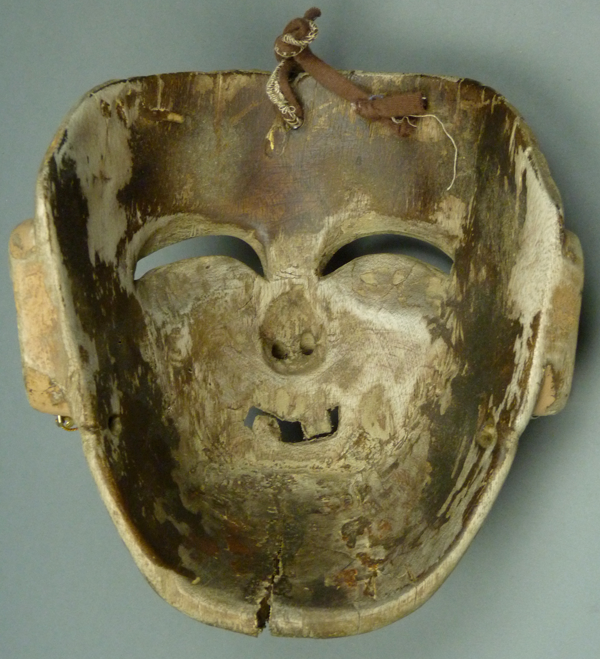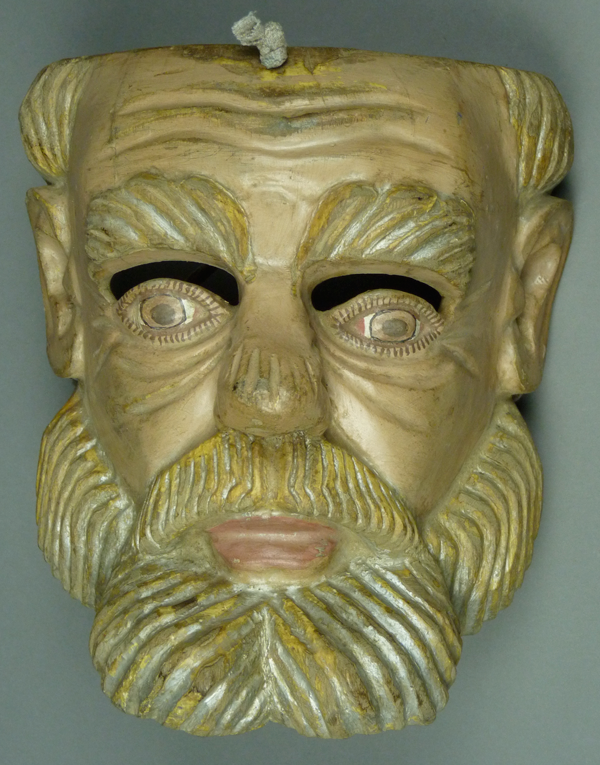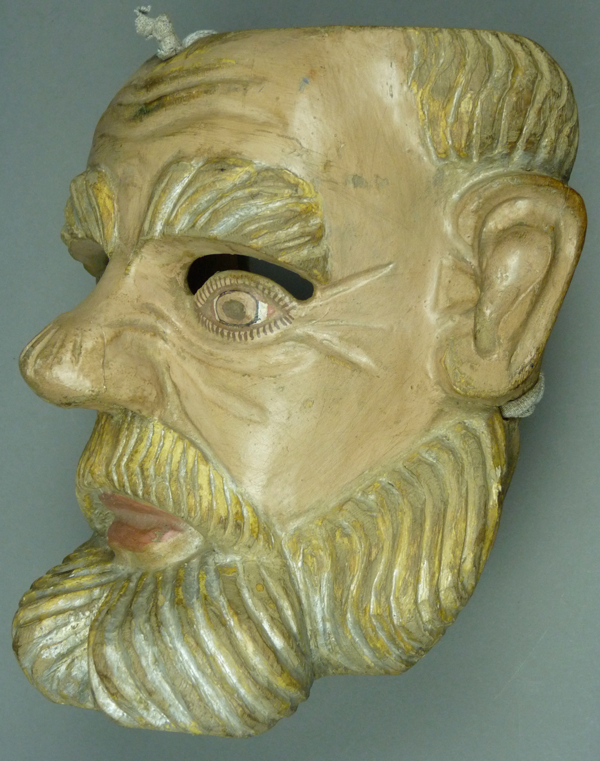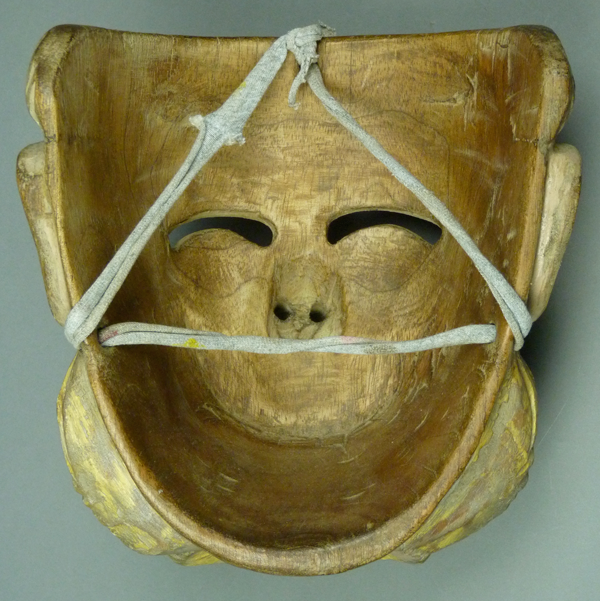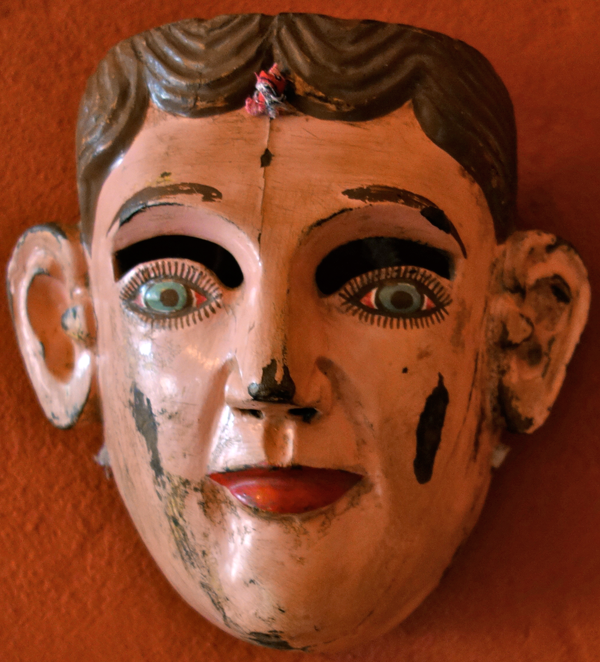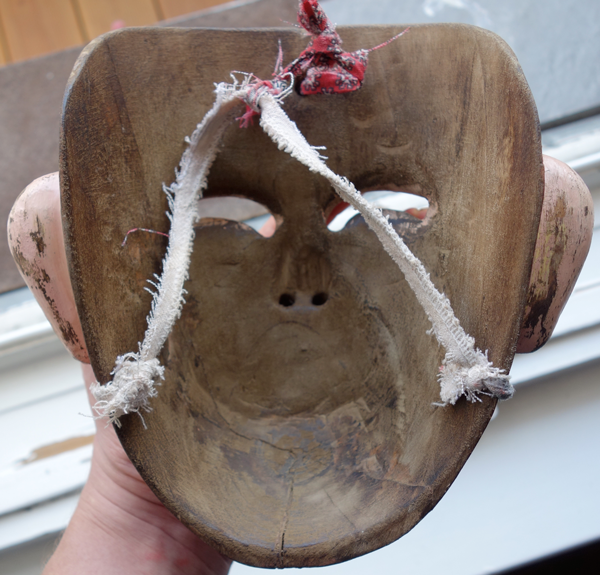PLEASE NOTE SOME NEW OPTIONS IN THE BLUE BAND AT THE TOP OF THE PAGE THAT WERE INTRODUCED SINCE THE LAST POST—Ask or Tell About a Mask, Privacy Policy, and Contact Me. The Ask or Tell option provides a convenient mechanism for you to upload interesting mask photos, either to ask about or to illustrate a comment. Contact Me opens a dialogue without the photo option. Privacy Policy is the usual Internet boilerplate that we all know only too well.
This post now ends with an addendum.
Last week I introduced you to the masks of Magno León, highlighting a number of features that tend to distinguish his masks from the work of others. There you may have noticed that a particular carver’s masks will share some features and not others, and that two masks by Magno will rarely be identical. Today I want to present some anonymous masks that I would attribute to this carver, based on overlapping features.
During a trip back to the Sierra de Puebla in December, 2012, I became particularly curious about a mask that was said to be worn each year during Carnaval (or Mardi Gras), in the small mountain village of Zapotitlán de Mendez, Puebla, by a dance character known as La Mujer de las Cebollas (the Onion Woman). When I passed through Zapotitlán in the company of Carlos Moreno Vázquez we questioned everyone that we met about this figure and we searched unsuccessfully for an example of her mask.
Here is what we were able to learn. The Mujer de las Cebollas character was modeled on rural farm women who lived in remote communities; they visited such towns as Zapotitlán on market days to sell their produce. But since this was a character in Carnaval, her vocation was only the beginning of the story. The dancer who played the Mujer was invariably male, but he wore the mask of a smiling old crone. He portrayed her as irritable and sensitive, prone to swing her broom in the air as she pursued children whom she experienced as disrespectful. Naturally such a character invited provocation from the mischievous, setting in motion an endless and entertaining chase. Obviously the Mujer de las Cebollas was a Carnaval clown.
Six months later I received a message from Carlos; he had found a wonderful old Mujer de las Cebollas mask, one that had been danced for about fifty years or more in Zapotitlán. He had also obtained the mask worn by this character’s husband. He believed that these had been carved by Magno León. As I will demonstrate, this impression can be easily validated by comparing the design details of these two masks to the reference standards described in last week’s post.
For those of you who watched the dance video of the Danza del Tigre in Xochistlahuaca, Guerrero, in a recent post, it will be apparent that such clown couples—a Viejo and a Vieja (an old man and an old woman)—are stock elements in the dance dramas of Mexico.
Here are those two masks, beginning with La Mujer de las Cebollas. Looking at the face of this mask one sees Magno’s usual relief carved eyes with arched vision openings. But because this is a character mask rather then the more refined face of a Huehue, the rest of the face is rather different from those we saw in the last post. From the side view, the usual ear design is present.
The wart on the chin was created with a bead that was nailed to the face.
This mask is 8 inches in height, 7½ inches in width, and 5 inches in depth. This angle provides a good view of the ear design.
Once again, because of the open mouth and toothy grin, this mask lacks the usual bowl shaped space at mouth level. The level of wear on the back of this mask is extreme.
This is the mask depicting the Husband of La Mujer. As yet I know nothing about his role. Again one sees the typical eyes and vision openings, the ears have the usual Magno León design, but the back lacks the bowl shaped space at mouth level.
The Husband’s mask is 8 inches in height, 7 inches in width, and 4½ inches in depth.
The back of this mask shows significant wear, but far less than what was present on the Mujer mask. There are the expected curved areas under the vision openings, there is a recessed area to accommodate the dancer’s nose, but instead of a bowl shaped depression at mouth level we find that the entire width of the mask has been carved out.
Helmut Hamm, a Mexican mask collector who lives in Berlin, Germany, just sent me a photo of an anonymous mask that he had recently purchased. This appeared to be a Huehue mask from the Sierra de Puebla, because it had the face of an attractive female whose mouth was closed and the mask had ears. A similar mask, but without carved ears, would probably be from some other region in Mexico, while one like this with an open mouth would probably have functioned as a Huehue female clown. I immediately looked at the ears to see if their design suggested a known carver and recognized Magno León’s hand. Although this might not be an optimal angle to assess most ears it was perfect in this case, because it accentuated the remarkable depth of the central areas, a feature that is extreme for some of Magno’s masks. If you compare these ears to those of La Mujer and her Husband, you will see that all three have the same ear design. I then asked Helmut to send a clear photo of the back, which revealed the bowl-shaped hollow to accommodate the dancer’s mouth, confirming my initial impression. That exchange triggered these posts about Magno León and his masks.
As I compared this mask to others by Magno León I noticed the special qualities of the vision openings over the relief-carved eyes, a feature that I had previously failed to notice on Magno’s other masks. So this mask taught me something new. I also saw much that was familiar, such as the relief carved eyes, the design of the nose, the carved groove under the nose, the design of the mouth, and the elaborate shaping of the chin.
Here is the back of the female Huehue mask from Germany. One sees what appear to be Magno’s typical carving around the vision slits, a hollow area to accommodate the dancer’s nose, and a bowl shaped depression at the level of the dancer’s mouth.
I hope that you have enjoyed learning more about Magno León. Next week I will discuss la danza de los Hormegas.
Addendum
In response to this post, Helmut Hamm and I had a further conversation, which led to further new observations. Briefly:
1. In general, this mask is not as attractive as the three Huehue masks in last weeks post. Her features seem to have been deliberately designed to make her look different than the female Huehues. For example, her ears are turned out to an unusual degree.
2. Furthermore, her eyes don’t look like the eyes of the Huehues in the last post. Instead they have blue/green irises and prominent red corners like those of the Onion Woman and her husband.
These differences suggest that this is not an ordinary Huehue mask after all, but instead a mask for a female Huehue clown or a mask to be worn by some other special character. Each carver has his own system to differentiate the Female Huehue masks from those of the female clowns and this discussion has clarified Magno León’s approach. Other carvers in this area seem to choose between two options—either they make their female clowns particularly pretty and vivacious or they depict them as goofy or strange in appearance. Magno seems to be following the latter course. Such reliance on negative stereotypes is not confined to Mexican mask makers in remote towns, of course. There are contemporary Mexican and South American television shows constructed around such stereotypes. Female Huehue clowns are sufficiently unusual that I have only seen about half a dozen of them, and as more emerge I am sure there will be more to learn.

